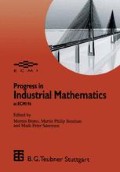Abstract
Combustion of wastes is an effective disposal technology. Although there are many examples of application in industry, severe environmental concerns are raised regarding the emissons from incinerators. Thermal treatment plants are usually comprised of a primary combustion chamber followed by a second combustion chamber, as schematically described in Fig. 1. During the oxidation of solid and liquid wastes in the primary chamber the mixing and the reaction conditions are inhomogeneous. Thus, the wastes undergo incomplete combustion and the gases traveling to the secondary stage of the reactor are rich in potentially hazardous products of incomplete combustion (PICs) together with unreacted wastes. For instance, incineration of chlorinated hydrocarbons can lead to highly toxic chemical species like polychlorinated dibenzo-p-dioxins (PCDDs) and polychlorinated dibenzofurans (PCDFs). The secondary chamber is the component of the plant which most strongly influences the air quality of the exhaust. Additionally, fuel (usually a waste) is injected to raise the temperature, promote better mixing of the reactants, and thus complete the oxidation of wastes. Formation of large droplets, quenching due to the existence of cold zones, and poor turbulent mixing of the gaseous reactants are examples of faults which may lead to unwanted emissions. In Germany, for instance, the BImSchG law (Bundes-Immissionsschutzgesetz) requires a residence time of 2s at a temperature of 1200°C for the combustion of chlorinated hydrocarbons to achieve their complete conversion. Nonetheless, the current regulation is not based on an adequate knowledge of the oxidation of halogenated species in the incineration systems [3].
Access this chapter
Tax calculation will be finalised at checkout
Purchases are for personal use only
Preview
Unable to display preview. Download preview PDF.
References
Barat R.B., Sarofim A.F., Longwell J.P., Bozelli J.W.: Inhibition of a Fuel Lean Ethylene/Air Flame in a Jet Stirred Combustor of Methyl Chloride: Experimental and Mechanistic Analysis Combust. Sci. and Tech., Vol.74, pp. 361378, 1990
Chen J.-Y.: Stochastic Modeling of Partially Stirred Reactors submitted to Combust. Sci. and Tech. 3/1995
Christill M., Kolb Th., Seifert H., Leukel W., Kufferath A.: Untersuchungen zum termischen Abbauverhalten chlorierter Kohlenwasserstoffe VDI Berichte Nr. 1193, pp. 381 – 388, 1995
Kee R.J., Rupley F.M., Miller J.A.: Chemkin-II: A Fortran Chemical Kinetics Package for the Analysis of Gas Phase Chemical Kinetics Sandia Report SAND89-8009B UC-706, 1993
Kraft M., Fey H., Schlegel A., Chen J.-Y., Bockhorn H.: A Numerical Study on the Influence of Mixing Intensity on NOx Formation. 3rd Workshop on Modelling of Chemical Reaction Systems Proceedings, to appear 1997
Pope S. B.: PDF Methods for Turbulent Reactive Flows Progress in Energy and Combustion Science, Vol. 11, pp. 119 – 192, 1985
Valiño L., Dopazo C.: A binomial Langevin model for turbulent mixing Phys. Fluids, A3(12), pp.3034–3037, 1991
Author information
Authors and Affiliations
Editor information
Editors and Affiliations
Rights and permissions
Copyright information
© 1997 B. G. Teubner Stuttgart
About this chapter
Cite this chapter
Kraft, M., Fey, H., Procaccini, C., Longwell, J.P., Sarofim, A.F., Bockhorn, H. (1997). Modeling the Thermal Decomposition of Chlorinated Hydrocarbons in an Ideal Turbulent Incinerator. In: Brøns, M., Bendsøe, M.P., Sørensen, M.P. (eds) Progress in Industrial Mathematics at ECMI 96. European Consortium for Mathematics in Industry, vol 9. Vieweg+Teubner Verlag, Wiesbaden. https://doi.org/10.1007/978-3-322-96688-9_13
Download citation
DOI: https://doi.org/10.1007/978-3-322-96688-9_13
Publisher Name: Vieweg+Teubner Verlag, Wiesbaden
Print ISBN: 978-3-322-96689-6
Online ISBN: 978-3-322-96688-9
eBook Packages: Springer Book Archive

